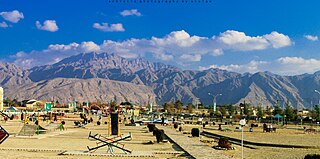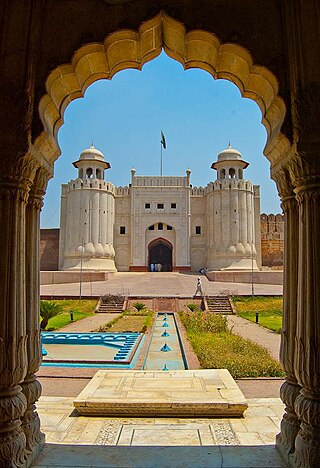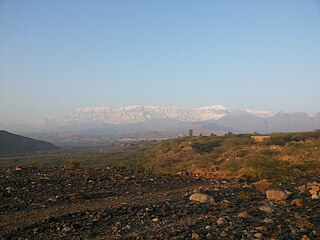| Sandeman Fort | |
|---|---|
| Zhob, Balochistan, Pakistan | |
| Coordinates | 31°20′55″N69°27′18″E / 31.34861°N 69.45500°E |
| Site history | |
| Built | 1890 |
| In use | Museum |
Sandeman Fort is a fortress and cantonment at Zhob, Balochistan, Pakistan.
| Sandeman Fort | |
|---|---|
| Zhob, Balochistan, Pakistan | |
| Coordinates | 31°20′55″N69°27′18″E / 31.34861°N 69.45500°E |
| Site history | |
| Built | 1890 |
| In use | Museum |
Sandeman Fort is a fortress and cantonment at Zhob, Balochistan, Pakistan.
The fort was built in 1890 on the orders of Robert Groves Sandeman, who led the British military campaign in the region. Built of limestone on high ground above the town, it has been compared in appearance to a ship, and was intended both for defence and, reportedly, to watch the local inhabitants. [1] [2] Accommodations for the garrison and officers were also built; Sandeman, who served as Governor General, and his successors as the local political agent lived in a residence at one end of the fort that is locally called the "castle". [3] [4]
After independence, the fort became the residence and office of the Assistant Commissioner of the district. [1] [2] On a visit to the military facilities in 1976, President Zulfiqar Ali Bhutto renamed the city, which had also been called Fort Sandeman, to Zhob. [3] [5]
The fort was declared a historical heritage site by the State of Balochistan, which in 2019 announced an agreement with the Walled City of Lahore Authority to restore it and associated buildings, with the Assistant Commissioner relocating in order for the fort to be opened to the public as a museum. [4] [5] It has retained furniture from the colonial era, including Sandeman's piano. [1] During restoration, concerns were raised that the original fabric was being demolished and replaced because the work was not overseen by archaeologists. [6] During British rule, a local man named Sher Jan Jogezai or Sher Jan Kakar shot the local agent, Major Barnes; [4] a statue of him pointing his gun now stands outside the residence. [7]

Balochistan is a province of Pakistan. Located in the southwestern region of the country, Balochistan is the largest province of Pakistan by land area but is the least populated one. It is bordered by the Pakistani provinces of Khyber Pakhtunkhwa to the north-east, Punjab to the east and Sindh to the south-east; shares international borders with Iran to the west and Afghanistan to the north; and is bound by the Arabian Sea to the south. Balochistan is an extensive plateau of rough terrain divided into basins by ranges of sufficient heights and ruggedness. It has the world's largest deep sea port, the Port of Gwadar lying in the Arabian Sea.

Quetta is the capital and largest city of the Pakistani province of Balochistan. It is the tenth largest city in Pakistan, with an estimated population of over 1.5 million in 2024. It is situated in the south-west of the country, lying in a valley surrounded by mountains on all sides. Quetta is at an average elevation of 1,680 metres above sea level, making it Pakistan's highest altitude major city. The city is known as the "Fruit Garden of Pakistan" due to the numerous fruit orchards in and around it and the large variety of fresh and dried fruits produced there.

The Lahore Fort is a citadel in the city of Lahore in Punjab, Pakistan. The fortress is located at the northern end of the Walled City of Lahore and spreads over an area greater than 20 hectares. It contains 21 notable monuments, some of which date to the era of Emperor Akbar. The Lahore Fort is notable for having been almost entirely rebuilt in the 17th century, when the Mughal Empire was at the height of its splendor and opulence.

Cantonments in Pakistan are permanent military bases of the Pakistan Army, which are administered by Cantonment Boards under the control of the Military Lands & Cantonments Department (ML&C), Ministry of Defence, Government of Pakistan. Cantonments are established under and governed by the Cantonments Act 1924.

Zhob, formerly known as Mandokhail,Fort Sandeman is a city and district headquarters of the Zhob District in the Balochistan province of Pakistan. Zhob is located on the banks of the Zhob river. It lies 337 kilometres away from Quetta, the capital of Balochistan.

The Chief Commissioner's Province of British Baluchistan was a province of British India established in 1876. Upon the creation of Pakistan it acceded to the newly formed state. It was part of the Baluchistan Agency. It was dissolved to form a united province of West Pakistan in 1955 upon the creation of One Unit Scheme.

The four provinces, capital territory, and two autonomous territories of Pakistan are subdivided into 38 administrative "divisions", which are further subdivided into districts, tehsils, and finally union councils. These divisions were abolished in 2000, but restored in 2008.

The Baluchistan Agency was one of the agencies of British India during the colonial era. It was located in the present-day Balochistan province of Pakistan.

Tourism in Pakistan is a growing industry. In 2010, Lonely Planet termed Pakistan "tourism's 'next big thing'". The country is geographically and ethnically diverse, and has a number of historical and cultural heritage sites. Condé Nast Traveller ranked Pakistan The Best Holiday Destination for 2020 and also declared it the third-highest potential adventure destination in the world for 2020. As security in the country improves, tourism increases; in two years, it has increased by more than 300%.

Sherani or Shirani is a rural district in the Zhob division of the Balochistan province of Pakistan. The district lies within the Sulaiman mountain range, and its highest point is the Takht-e-Sulaiman.

The Governor of Balochistan is the head of the province of Balochistan, Pakistan. The post was established on 1 July 1970, after the dissolution of West Pakistan province and the end of One Unit. Under Pakistan's current parliamentary system, the governorship is a ceremonial position, as a symbol of the federation. The governor is appointed by the centre, whereas the principal head of the provincial government remains the elected Chief Minister of Balochistan.
Bostan (بوستان) is a town, 30 km by road (18.64 mi) from Quetta city in the Balochistan province of Pakistan.It is located at 30°25'57N 67°00'22E and has an altitude of 1593 metres. Bostan is Tehsil of the Pishin District. It was previously included in Tehsil Karezat and covers an area between Mount Takathu and the Red Hills.

Wali Kirani was a Muslim saint. His date of birth and date of death are not known, but is believed to have lived around the time of Sultan Hussain Mirza's rule in Herat around 1470.
Killa Saifullah, or Qilla Saifullah, is a city in the Killa Saifullah District of the Balochistan province of Pakistan. A fort (qilla) built in the district by Saifullah Khan, belonging to the Mirdadzai Khoidadza sub-clan of Kakar tribe, has lent its name to the city.

Shams-ud-din Harifal was an was an Islamic Sunni Hanafi scholar of the Deobandi school of thought and political leader of Jamiat Ulema-e-Islam and Tehreek-e-Khatme-e-Nubuwwat. According to his biographer, Shams-ud-din's major contribution was his support of strong anti-Ahmadiyya feelings among Muslims at the risk and sacrifice of his life.
Baba-e-Afghan Abdul Rahim Khan Mandokhail was a Pashtun Afghan nationalist and politician who had been a member of the National Assembly of Pakistan, the Provincial Assembly of Balochistan, and the Senate of Pakistan.
The Zhob Valley Railway was one of several branch lines in Pakistan, operated and maintained by Pakistan Railways. The line began at Bostan Junction and ended at Zhob. The total length of this railway line is 298 kilometers (185 mi) with 14 railway stations. Upon competition, the 762 mm railway became the longest narrow gauge system in the region.
Jamal Khan Mandokhail is the Justice of the Supreme Court of Pakistan since 9 August 2021. He was a former Chief Justice of Balochistan High Court from 5 October 2019 to 9 August 2021.

Governor's House, formerly known as the Quetta Residency, is a historical government building located on Zarghun Road in Quetta, Balochistan, Pakistan. It serves as the official residence of the governor of Balochistan.